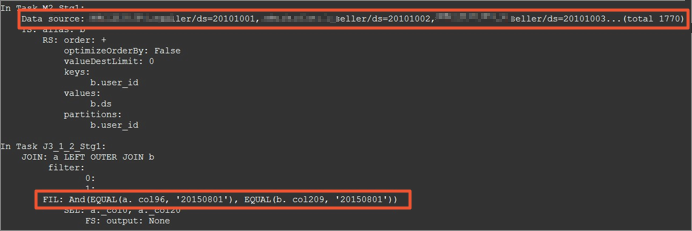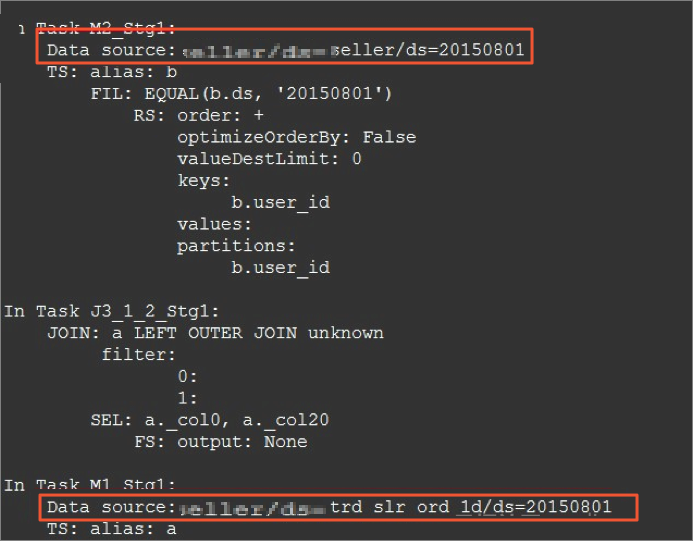This topic describes how to check whether partition pruning is effective.
Background information
A MaxCompute partitioned table is a table with partitions. You can specify one or more columns as the partition key to create a partitioned table. If you have specified the name of a partition that you want to access, MaxCompute reads data only from that partition and does not scan the entire table. This reduces costs and improves efficiency.
Partition pruning allows you to specify filter conditions for partition key columns. This way, MaxCompute reads data only from the partitions that meet the filter conditions that you have specified in SQL statements. This avoids the errors and waste of resources that are caused by full table scans. However, partition pruning may not take effect sometimes.
- Check whether partition pruning is effective
- Scenarios where partition pruning does not take effect
Check whether partition pruning is effective
- For a query where partition pruning does not take effect:
explain select seller_id from xxxxx_trd_slr_ord_1d where ds=rand();The execution plan indicates that all the 1,344 partitions of Table xxxxx_trd_slr_ord_1d are read.
- For a query where partition pruning is effective:
explain select seller_id from xxxxx_trd_slr_ord_1d where ds='20150801';
The execution plan indicates that only Partition 20150801 of Table xxxxx_trd_slr_ord_1d is read.
Scenarios where partition pruning does not take effect
- Improper use of UDFs
If you use user-defined functions (UDFs) or specific built-in functions to specify partitions, partition pruning may not take effect. In this case, we recommend that you execute the EXPLAIN statement to check whether partition pruning is effective.
explain select ... from xxxxx_base2_brd_ind_cw where ds = concat(SPLIT_PART(bi_week_dim(' ${bdp.system.bizdate}'), ',', 1), SPLIT_PART(bi_week_dim(' ${bdp.system.bizdate}'), ',', 2))Note For more information about UDF-based partition pruning, see the "WHERE" section in WHERE. - Improper use of joins
When you join tables, pay attention to the following rules:
- If partition pruning conditions are specified in the WHERE clause, partition pruning is effective.
- If partition pruning conditions are specified in the ON clause, partition pruning is effective for the secondary table, but not the primary table.
The following examples describe how partition pruning works when three different types of JOIN operations are performed:- LEFT OUTER JOIN
- For a query where partition pruning conditions are specified in the ON clause:
set odps.sql.allow.fullscan=true; explain select a.seller_id ,a.pay_ord_pbt_1d_001 from xxxxx_trd_slr_ord_1d a left outer join xxxxx_seller b on a.seller_id=b.user_id and a.ds='20150801' and b.ds='20150801';
The execution plan indicates that partition pruning is effective for the right table, but not the left table.
- For a query where partition pruning conditions are specified in the WHERE clause:
set odps.sql.allow.fullscan=true; explain select a.seller_id ,a.pay_ord_pbt_1d_001 from xxxxx_trd_slr_ord_1d a left outer join xxxxx_seller b on a.seller_id=b.user_id where a.ds='20150801' and b.ds='20150801';
The execution plan indicates that partition pruning is effective for both tables.
- For a query where partition pruning conditions are specified in the ON clause:
- RIGHT OUTER JOIN
A RIGHT OUTER JOIN operation is similar to a LEFT OUTER JOIN operation. If partition pruning conditions are specified in the ON clause, partition pruning is effective only for the left table, but not the right table. If partition pruning conditions are specified in the WHERE clause, partition pruning is effective for both tables.
- FULL OUTER JOIN
Partition pruning is effective only when partition pruning conditions are specified in the WHERE clause, but not the ON clause.
Impact and consideration
- If partition pruning does not take effect, the query performance can be greatly deteriorated. This issue can be hardly discovered. We recommend that you check whether partition pruning is effective before you commit the code.
- To use UDFs for partition pruning, you must modify the classes of the UDFs or add
set odps.sql.udf.ppr.deterministic = true;before the SQL statements to execute. For more information, see WHERE.


